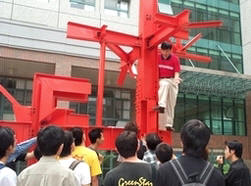

Following the devastating 921 Earthquake of 1999 in Taiwan, which disclosed many problems with existing reinforced concrete structures, structural steel became much more popular as a construction material. Many failures of reinforced concrete structures were attributed to inadequate methods of construction and insufficient quality control, problems that may be overcome with structural steel construction that has demonstrated high reliability in resistance to seismic loading. However, while the concept of structural steel construction has become popular, the actual application lags behind the potential.
In general, seismic resistance is a function of both the general arrangement of structural elements and the structural details, particularly connection details. If a design engineer focuses on the general arrangement and strength of structural members, but neglects the connection details, the seismic resistance of the structure can be dangerously impaired. Historically, there are more structural failures associated with inadequate connection details than with any other component of design.
In the typical introductory college course in steel design, it is natural put off the discussion of connection design until the final few weeks of the term. Then all to often, with all the other pressures crushing the end of the semester, the topic of connections gets compressed to only a few lectures. Too often, this practice of slighting connections in the steel course is rationalized with the misguided view that connection design is merely a “detailing problem”. Or the connection design is trivialized because one can go to the AISC Manual to pull out a standard connection. Many times, the engineer simply indicates the load to be transferred and the fabricator is expected to select an appropriate connection.
In order to partially offset the shortcomings in steel connection education,
Professor Duane Ellifritt proposed to create a full scale steel “sculpture,”
which includes various types of connections, and place it where students
could see it often and become familiar with connections. The sculpture was
completed and erected at the University of Florida in October of 1986.
Since then, many other universities have requested copies of the plans from
the University of Florida and built their own structures.
Based on the above concept, Professor Shengmin B. Wu proposed to establish a steel sculpture comprised of about 40 types of connections in order to promote and enhance steel construction in Taiwan. Wu Steel Sculpture was erected on the campus of ChaoYang University of Technology, Taiwan, ROC, in May of 2002.
In order to make the teaching-oriented steel sculpture more accessible, Wu Steel Sculpture is also constructed virtually: a 3-D animated and interactive model is placed on the internet where it may be conveniently visited by students and practicing designers alike, as often as they please, without leaving the comfort of their home or office.
















